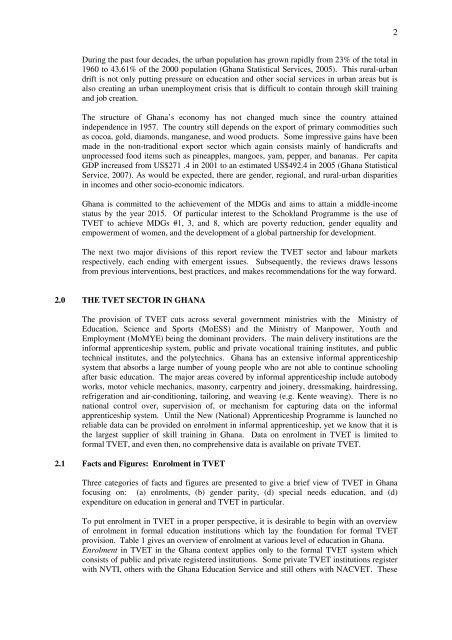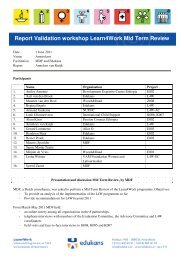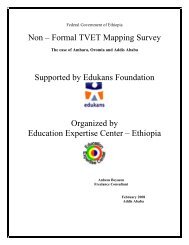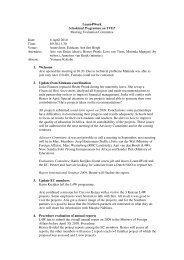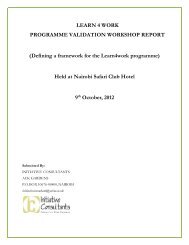DRAFT TECHNICAL AND VOCATIONAL EDUCATION AND ...
DRAFT TECHNICAL AND VOCATIONAL EDUCATION AND ...
DRAFT TECHNICAL AND VOCATIONAL EDUCATION AND ...
Create successful ePaper yourself
Turn your PDF publications into a flip-book with our unique Google optimized e-Paper software.
2<br />
During the past four decades, the urban population has grown rapidly from 23% of the total in<br />
1960 to 43.61% of the 2000 population (Ghana Statistical Services, 2005). This rural-urban<br />
drift is not only putting pressure on education and other social services in urban areas but is<br />
also creating an urban unemployment crisis that is difficult to contain through skill training<br />
and job creation.<br />
The structure of Ghana’s economy has not changed much since the country attained<br />
independence in 1957. The country still depends on the export of primary commodities such<br />
as cocoa, gold, diamonds, manganese, and wood products. Some impressive gains have been<br />
made in the non-traditional export sector which again consists mainly of handicrafts and<br />
unprocessed food items such as pineapples, mangoes, yam, pepper, and bananas. Per capita<br />
GDP increased from US$271 .4 in 2001 to an estimated US$492.4 in 2005 (Ghana Statistical<br />
Service, 2007). As would be expected, there are gender, regional, and rural-urban disparities<br />
in incomes and other socio-economic indicators.<br />
Ghana is committed to the achievement of the MDGs and aims to attain a middle-income<br />
status by the year 2015. Of particular interest to the Schokland Programme is the use of<br />
TVET to achieve MDGs #1, 3, and 8, which are poverty reduction, gender equality and<br />
empowerment of women, and the development of a global partnership for development.<br />
The next two major divisions of this report review the TVET sector and labour markets<br />
respectively, each ending with emergent issues. Subsequently, the reviews draws lessons<br />
from previous interventions, best practices, and makes recommendations for the way forward.<br />
2.0 THE TVET SECTOR IN GHANA<br />
The provision of TVET cuts across several government ministries with the Ministry of<br />
Education, Science and Sports (MoESS) and the Ministry of Manpower, Youth and<br />
Employment (MoMYE) being the dominant providers. The main delivery institutions are the<br />
informal apprenticeship system, public and private vocational training institutes, and public<br />
technical institutes, and the polytechnics. Ghana has an extensive informal apprenticeship<br />
system that absorbs a large number of young people who are not able to continue schooling<br />
after basic education. The major areas covered by informal apprenticeship include autobody<br />
works, motor vehicle mechanics, masonry, carpentry and joinery, dressmaking, hairdressing,<br />
refrigeration and air-conditioning, tailoring, and weaving (e.g. Kente weaving). There is no<br />
national control over, supervision of, or mechanism for capturing data on the informal<br />
apprenticeship system. Until the New (National) Apprenticeship Programme is launched no<br />
reliable data can be provided on enrolment in informal apprenticeship, yet we know that it is<br />
the largest supplier of skill training in Ghana. Data on enrolment in TVET is limited to<br />
formal TVET, and even then, no comprehensive data is available on private TVET.<br />
2.1 Facts and Figures: Enrolment in TVET<br />
Three categories of facts and figures are presented to give a brief view of TVET in Ghana<br />
focusing on: (a) enrolments, (b) gender parity, (d) special needs education, and (d)<br />
expenditure on education in general and TVET in particular.<br />
To put enrolment in TVET in a proper perspective, it is desirable to begin with an overview<br />
of enrolment in formal education institutions which lay the foundation for formal TVET<br />
provision. Table 1 gives an overview of enrolment at various level of education in Ghana.<br />
Enrolment in TVET in the Ghana context applies only to the formal TVET system which<br />
consists of public and private registered institutions. Some private TVET institutions register<br />
with NVTI, others with the Ghana Education Service and still others with NACVET. These


